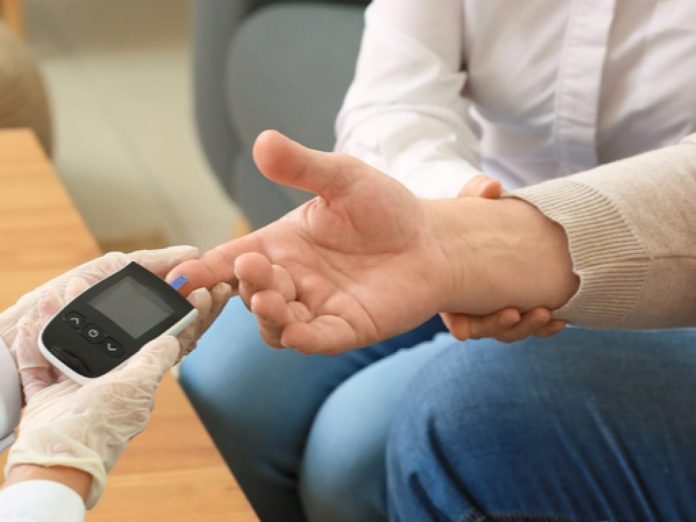Type 1 diabetes is a chronic disease. In people with type 1 diabetes, cells in the pancreas that make insulin are destroyed, so the body is unable to make insulin.
Insulin is a hormone that helps your body’s cells use glucose (sugar) for energy. Your body gets glucose from the food you eat. Insulin allows the glucose to pass from your blood into your body’s cells.
When the cells have enough, your liver and muscle tissues store the extra glucose in the form of glycogen. It’s broken down into blood sugar and released when you need energy between meals, during exercise, or while you sleep.
With type 1 diabetes, your body is unable to process glucose due to the lack of insulin.
Glucose from your food can’t make its way into your cells. This leaves too much glucose circulating in your blood. High blood sugar levels can lead to both short- and long-term problems.
Symptoms of type 1 diabetes
The following are symptoms of type 1 diabetes:
excessive hunger
excessive thirst
blurred vision
fatigue
frequent urination
dramatic weight loss in a short period of time
If you have one or more type 1 diabetes symptoms, you should contact a healthcare professional.
If you have symptoms of ketoacidosis, you should get medical help right away. Ketoacidosis is a medical emergency.
Type 1 vs. type 2 diabetes
There are two main types of diabetes: type 1 and type 2. They have similar symptoms and over time, they can lead to many of the same complications. However, they are very different diseases.
Type 1 diabetes is the result of a person’s body not producing insulin on its own. Taking insulin is necessary for survival, to move glucose from the bloodstream into the body’s cells.
For people with type 2 diabetes, the cells have stopped responding well to insulin. The body struggles to move glucose from the blood into the cells, despite having adequate levels of the hormone. Eventually, their bodies may stop making adequate insulin entirely.
Type 1 diabetes develops very quickly and symptoms are obvious. For people with type 2 diabetes, the condition can develop over many years. In fact, a person with type 2 diabetes may not know they have it until they have a complication.
The two types of diabetes are caused by different things. They also have unique risk factors.
Causes of type 1 diabetes
Researchers don’t know the exact cause of type 1 diabetes.
It is thought to be an autoimmune reaction, in which the body attacks the cells in the pancreas that make insulin by mistake, per the Centers for Disease Control and Prevention (CDC)Trusted Source. But scientists don’t fully understand why this happens.
Some people may be predisposed to develop the condition due to genetics, according to the American Diabetes Association (ADA). Other people may get it due to environmental factors, such as diet. Viruses may also play a part. Sometimes a combination of these factors will trigger the condition.
Type 1 diabetes risk factors
Risk factors for type 1 diabetes are poorly understood. In many ways, they are similar to causes of diabetes.
This is because the factors that may trigger type 1 diabetes for some people may not trigger it for others.
Researchers have identified some potential risk factors:
Race
Race may be a risk factor for type 1 diabetes. People who are white may have more genetic predisposition to type 1 diabetes, since the condition is more common in this group.
Environmental factors
Some viruses may trigger type 1 diabetes as well. It’s unclear which ones might do this, however.
Likewise, people from cold climates are more likely to have type 1 diabetes. Doctors also diagnose more cases of type 1 in winter than they do in summer.
Several other components may influence who develops type 1 diabetes.
Read about these possible risk factors and the research underway to better understand why some people develop the disease.
Genetic factors
Researchers don’t understand exactly what causes type 1 diabetes. However, they believe that your genes may play a role, both in terms of the genes you inherit and your family’s history of diabetes.
People who have type 1 diabetes are born with a greater likelihood of developing the disease. It does appear to be passed down through generations of a family. It’s unclear how the pattern works and why some people in a family will develop diabetes while others will not.
Researchers have identified certain gene variants that may increase a person’s risk. These variants can be shared between parent and child, generation after generation. However, not everyone who has these genes develops type 1 diabetes.
That’s why researchers believe genes are only one part of the equation. They think something triggers the condition in people who have the inherited genes. A virus is one suspected trigger.
For example, identical twins, who have all the same genes, may not both develop the condition. If one twin has type 1 diabetes, the other twin develops the condition half of the time or less. This suggests that genes aren’t the only factor.
Type 1 diabetes treatment
If you receive a diagnosis of type 1 diabetes, your body can’t make its own insulin. You’ll need to take insulin to help your body use the sugar in your blood.
Other treatments may also hold some promise for controlling symptoms of type 1 diabetes.
Insulin
People with type 1 diabetes must take insulin every day. You usually take the insulin through an injection.
Some people use an insulin pump. The pump injects insulin through a port in the skin. This can be easier for some people than sticking themselves with a needle. It may also help level out blood sugar highs and lows.
The amount of insulin you need varies throughout the day. People with type 1 diabetes regularly test their blood sugar to figure out how much insulin they need. Both diet and exercise can affect blood sugar levels.
Several insulin types exist. Your doctor may have you try more than one to find what works best for you.
Metformin
Metformin is a type of oral diabetes medication. For many years, it was approved only for people with type 2 diabetes.
However, some people with type 1 diabetes can develop insulin resistance. That means the insulin they get from injections doesn’t work as well as it should. These days, doctors sometimes prescribe Metformin for type 1 patients.
Metformin helps lower sugar in the blood by reducing sugar production in the liver. Your doctor may advise you to take Metformin in addition to insulin.
Vaccines
The tuberculosis vaccine may possibly have some benefit as a treatment for people with type 1 diabetes but the data is very limited.
One 2012 study found that the bacillus Calmette-Guérin (BCG) may have some impact on the autoimmune response that may be triggering type 1 diabetes. Since then, there’s been more research into the BCG vaccine and its potential use as a treatment tool for diabetes and other conditions.
The evidence for the vaccine’s use in diabetes remains controversial, though. A 2018 suggests some promise, but at least one 2020 study does not.
Other medications
There is a new oral medication for people with type 1 diabetes. This drug will be the first oral medication designed to be used alongside insulin in people with type 1 diabetes, according to a 2019 research review.
It works to lower glucose levels in the blood by forcing the body to expel it in urine and by reducing glucose absorption in the gut. Similar medications already exist for people with type 2 diabetes, but none are approved for people with type 1.
However, Sotagliflozin (Zynquista) was denied by the FDA in 2019 due to some concerns about the medication as it’s currently produced.
On the other hand, the medication has been approved by the European Medicines Agency (EMA). This raises the possibility that FDA may at some point still approve it in the United States.
Diagnosis of type 1 diabetes
Healthcare professionals usually diagnose type 1 diabetes through a series of tests. Some can be conducted quickly, while others require hours of preparation or monitoring.
Type 1 diabetes often develops quickly. According to the CDCT, a healthcare professional can make a diabetes diagnosis if:
Fasting blood sugar is greater than 126 mg/dL on two separate tests.
Random blood sugar is greater than 200 mg/dL, along with symptoms of diabetes.
Hemoglobin A1c is greater than 6.5 on two separate tests.
Doctors also use the same criteria to diagnose type 2 diabetes. In fact, people with type 1 diabetes are sometimes misdiagnosed as having type 2.
A doctor may not realize you’ve been misdiagnosed until you begin developing complications or worsening symptoms despite treatment.
When blood sugar gets so high that diabetic ketoacidosis occurs, you become very ill. This is often the reason people end up in the hospital or their doctor’s office, and type 1 diabetes is then diagnosed.
If you have any of the symptoms of diabetes, your doctor will likely order tests.
Complications
The two most common complications are hypoglycemia and diabetic ketoacidosis.
Hypoglycemia happens when your blood sugar is too low, usually when your body has too much insulin. It can happen if you wait too long to eat or have a snack, or if you exercise too much.
Ketoacidosis can be a life threatening condition. This when your body doesn’t have enough insulin. Symptoms of this condition include:
rapid breathing
dry skin and mouth
flushed face
fruity breath odor
nausea
vomiting or stomach pain
In addition, high blood sugar levels can cause damage to various parts of the body. Symptoms can include:
increased heart attack risk
eye problems, including blindness
nerve damage
infections on the skin, especially the feet, that could require amputation in serious cases
kidney damage
Diabetes can also damage your nerves and lead to a condition called diabetic neuropathy. This is common in the feet.
Small cuts, especially on the bottom of your feet, can quickly turn into severe ulcers and infections, especially if blood sugar levels aren’t controlled. This is because you can’t feel or see the cuts, so you don’t treat them.
That is why it’s important to check your feet regularly if you have diabetes. If you happen to notice any foot injuries, let your doctor know right away.
People with type 1 diabetes should also pay attention to other changes to their bodies. Read more about the possible effects diabetes can have on your body.
Type 1 diabetes in children
Type 1 diabetes was once known as juvenile diabetes. That is because it’s frequently diagnosed in children and young adults. By comparison, type 2 diabetes is typically diagnosed in older adults. However, both types can be diagnosed at almost any age.
According to a 2015 self-reported , symptoms of diabetes in children include:
weight loss
wetting the bed or urinating more often
feeling weak or fatigued
being hungry or thirsty more often
mood changes
blurred vision
As in adults, children with type 1 diabetes are treated with insulin.
The first generation of an artificial pancreas has been recently approved for use in children. This device is inserted under the skin. Then, it measures blood sugar continuously, automatically releasing the right amount of insulin as needed.
Most children still use manual methods for insulin injections and glucose monitoring. In young children especially, this requires a lot of work by parents to keep them safe and healthy.
Life expectancy and statistics
Currently, more than 1.6 million Americans are living with type 1 diabetes, including about 187,000 children and adolescents.
Diabetes (type 1 and type 2) is the seventh leading cause of death in the United States, according to the CDC. About 5 to 10 percent of the people who have diabetes have type 1.
Properly managing the condition can help reduce complications and prolong life expectancy.
Diabetes is a condition that affects people worldwide. Read more about where and how often it occurs.





























